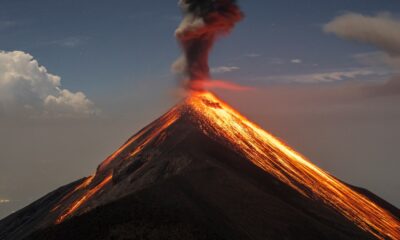Science
Researchers Discover Vortex Behavior in Chiral Liquid Crystals

Researchers have uncovered a fascinating connection between vortex-like defects in chiral liquid crystals and the behavior of superconductors. Their findings reveal that these defects can form structured arrangements known as Abrikosov clusters, which closely resemble patterns seen in Type-II superconductors. This research opens new avenues for understanding the physics of both materials and their potential applications.
Understanding Superconductivity and Vortex Formation
Superconductors are unique materials that, when cooled below a certain critical temperature, exhibit zero electrical resistance and completely expel magnetic fields, a phenomenon termed the Meissner effect. They are classified into two main types. Type-I superconductors repel magnetic fields entirely but lose their superconducting properties when the magnetic field exceeds a specific threshold. In contrast, Type-II superconductors possess two critical field values, allowing them to transition through different states as the magnetic field increases.
In Type-II superconductors, magnetic flux penetrates the material at discrete points, forming quantized vortices that repel each other. These vortices self-organize into a regular structure known as the Abrikosov lattice. This self-organization has also been observed in other systems, including Bose-Einstein condensates and chiral magnets, indicating a broader phenomenon in physics.
New Insights from Chiral Liquid Crystals
The recent study led by V. Fernandez-Gonzalez and colleagues investigates vortex behavior in liquid crystal droplets. Researchers have identified a new phenomenon where these liquid crystals exhibit similar self-organization to that of superconductors. Upon cooling from an isotropic liquid phase to a chiral liquid phase, vortex-like defects emerge, clustering together to form what the researchers term Abrikosov clusters.
Through a combination of experimental observations and theoretical modeling, the team demonstrated how chiral domains—essentially topological defects—cluster due to the interplay between vortex repulsion and the confinement effects of the droplet. The researchers applied a mathematical framework known as the Ginzburg-Landau equation, originally developed for studying superconductivity, to analyze how these vortex patterns arise by minimizing the system’s energy.
One particularly intriguing finding is that light passing through the chiral domains of the droplet can acquire chirality. This suggests potential applications for steering and shaping light, which could be advantageous for data communication and astronomical imaging.
The complete findings of this research are documented in the paper titled “Abrikosov clusters in chiral liquid crystal droplets,” published in Rep. Prog. Phys. in 2024. This study not only enhances our understanding of vortex dynamics in liquid crystals but also bridges knowledge between distinct fields of condensed matter physics.
As researchers continue to explore these connections, the implications for technology and fundamental physics could be profound, paving the way for future innovations in material science.
-

 World5 days ago
World5 days agoCoronation Street’s Shocking Murder Twist Reveals Family Secrets
-

 Entertainment4 months ago
Entertainment4 months agoKate Garraway Sells £2 Million Home Amid Financial Struggles
-

 Entertainment3 months ago
Entertainment3 months agoAnn Ming Reflects on ITV’s ‘I Fought the Law’ Drama
-

 Entertainment2 days ago
Entertainment2 days agoAndrew Pierce Confirms Departure from ITV’s Good Morning Britain
-

 Health3 months ago
Health3 months agoKatie Price Faces New Health Concerns After Cancer Symptoms Resurface
-

 Entertainment4 weeks ago
Entertainment4 weeks agoCoronation Street Fans React as Todd Faces Heartbreaking Choice
-

 World4 weeks ago
World4 weeks agoBailey Announces Heartbreaking Split from Rebecca After Reunion
-

 Entertainment1 week ago
Entertainment1 week agoTwo Stars Evicted from I’m A Celebrity Just Days Before Finale
-

 World1 week ago
World1 week agoKevin Sinfield Exceeds Fundraising Goal Ahead of Final Marathons
-

 Entertainment3 months ago
Entertainment3 months agoCoronation Street’s Carl Webster Faces Trouble with New Affairs
-

 Entertainment3 months ago
Entertainment3 months agoWhere is Tinder Swindler Simon Leviev? Latest Updates Revealed
-

 Entertainment4 months ago
Entertainment4 months agoMarkiplier Addresses AI Controversy During Livestream Response





















